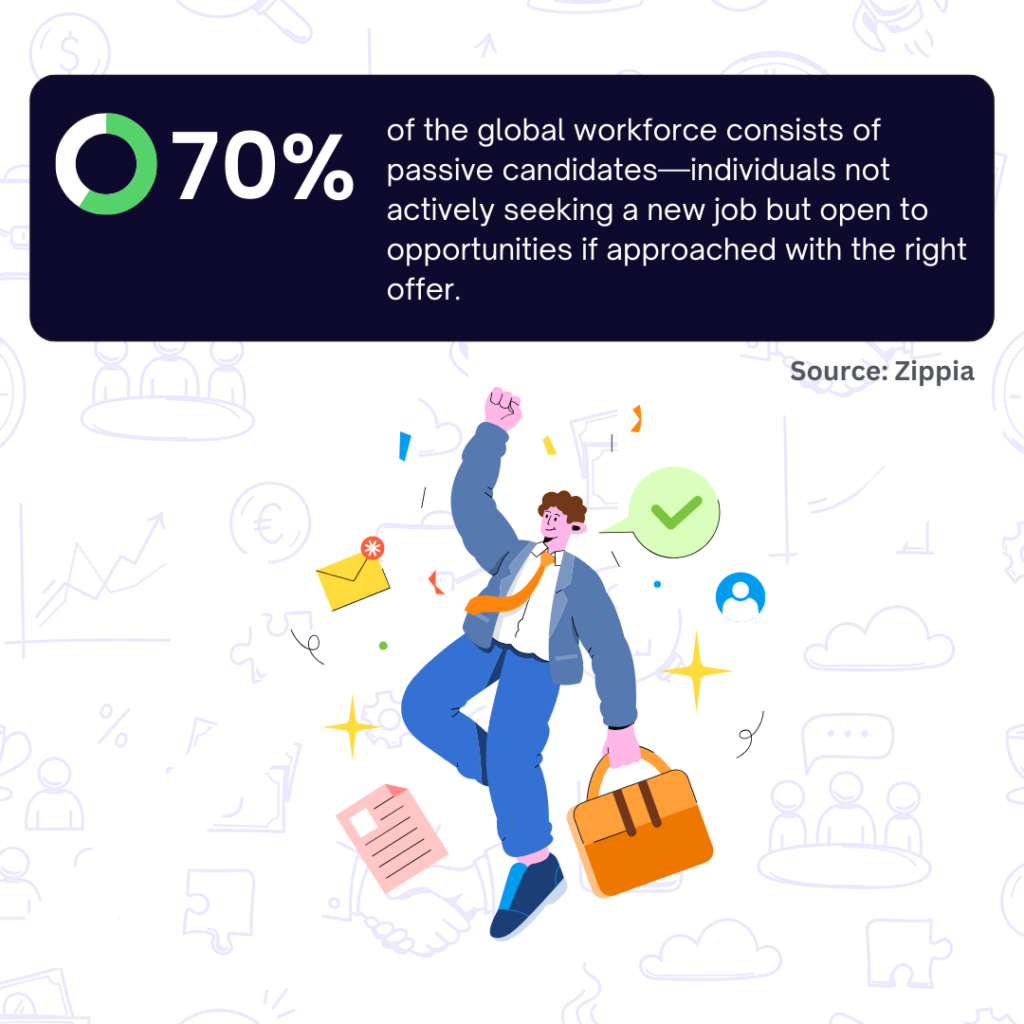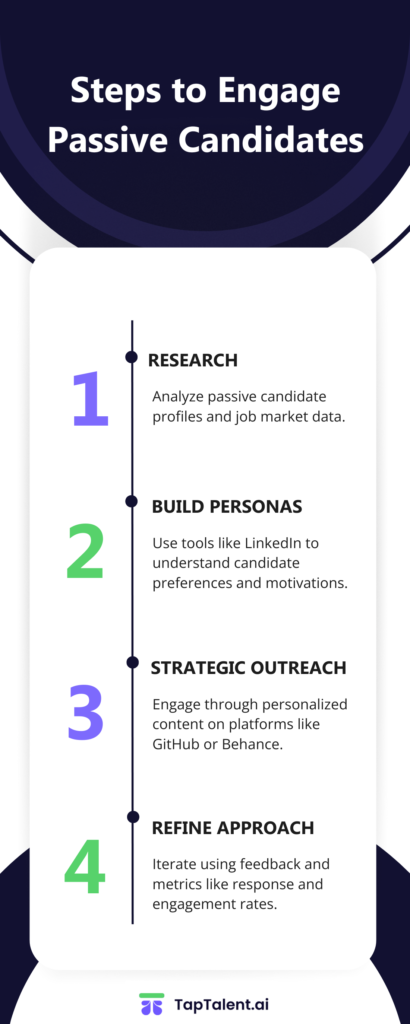Engaging passive candidates is the ultimate recruitment challenge—and opportunity. These individuals, while not actively seeking new roles, often possess the skills, experience, and potential to elevate your organization. In fact, studies reveal that passive candidates account for 70% of the global workforce and are 120% more likely to excel in their roles. So, how do you attract this talent pool? It requires more than a job post. You need strategic employer branding, personalized outreach, and advanced tools to pique their interest and foster meaningful connections. Whether you’re a recruiter, startup founder, or business owner, mastering passive candidate engagement can set you apart in today’s competitive talent market. Ready to learn the science behind it? Dive into actionable strategies that will help you connect with, nurture, and convert passive talent into your next great hire.

Understanding Passive Candidates
Who Are Passive Candidates?
Passive candidates are individuals who are currently employed and not actively searching for a new job but may be open to the right opportunity if approached strategically. These professionals often excel in their roles, bringing valuable experience and expertise to the table. Unlike active job seekers, they’re not actively scouring job boards or submitting resumes, making them harder to identify—but their potential impact is immense. According to research, passive candidates are 120% more likely to contribute significantly to an organization’s success than active candidates.
Why Passive Candidates Matter
Engaging passive candidates is a game-changing recruitment strategy. These professionals typically exhibit desirable traits such as stability, strong skills, and proven track records. Since they are not urgently looking for a job, they often approach opportunities with greater discernment, ensuring they align well with the company’s culture and goals.
Moreover, focusing on passive candidates helps you build a proactive talent pipeline, reducing time-to-hire and ensuring you have access to top talent even in a competitive market. By engaging these individuals, businesses can future-proof their workforce, gain a competitive edge, and foster innovation.

Building a Passive Candidate Persona
Creating Targeted Profiles
To effectively engage passive candidates, start by crafting detailed candidate personas. These personas are data-driven profiles that help recruiters understand what motivates passive candidates, their job preferences, and potential pain points. Leverage tools like LinkedIn Analytics to gather insights on their career history, skills, and connections. AI-powered platforms, such as TapTalent, can also analyze behavioral data to highlight trends in candidate interests and priorities.
For example, consider whether your ideal passive candidate values career growth, work-life balance, or innovative projects. Use this information to tailor your outreach and align opportunities with their personal and professional goals.
Adopting a Personal Touch
Once you’ve built your personas, customize your messaging to connect with their aspirations. A generic email won’t stand out—personalization is key. Use their recent achievements, shared industry interests, or professional milestones to craft an authentic approach.
For instance, instead of a standard “We have an opening” message, try:
“Hi [Name], I came across your recent project on [specific topic] and was impressed by your innovative approach. We’re currently looking for professionals with your expertise to lead similar initiatives.”
This personalized outreach builds trust and demonstrates that you understand their unique value. Case studies show that candidates are more likely to respond when messaging speaks directly to their ambitions and highlights opportunities for impact.
Leveraging Advanced Recruitment Strategies
Engaging passive candidates requires a multi-pronged approach that combines the power of branding, strategic use of digital platforms, and the latest technology. Here’s how to unlock the potential of advanced recruitment strategies:
Using Employer Branding as a Magnet
Passive candidates often evaluate employers based on what they can learn from a company’s online presence. To attract them, employer branding is crucial.
-
Showcasing Culture and Values: A strong employer brand communicates your company culture, values, and mission. Use blog posts, behind-the-scenes videos, and testimonials from current employees to highlight the aspects that make your organization unique. For instance, sharing “A Day in the Life” series on platforms like LinkedIn can humanize your brand.
-
Promoting Growth Opportunities: Passive candidates are likely to be employed but might be enticed by better growth opportunities. Clearly communicate advancement potential, upskilling programs, and mentorship initiatives in your marketing materials.
-
Employer Profiles on Key Platforms: Ensure your profiles on Glassdoor, LinkedIn, and other relevant platforms are complete and appealing. Highlight benefits like flexible work policies, employee wellness programs, and competitive compensation packages. Remember, 75% of job seekers research a company’s reputation before applying.
Engaging on Passive Channels
-
Social Media Strategies: Platforms like Instagram and Facebook are excellent for creating interest without being overly intrusive. Share success stories, thought-leadership content, and even polls or quizzes related to your industry. These methods spark curiosity and build a connection.
-
Industry-Specific Platforms: Target professionals where they showcase their expertise. Developers, for instance, frequent GitHub, while creatives may use Behance or Dribbble. Contributing to these communities through meaningful engagement, like endorsing projects or commenting on posts, establishes your company as approachable and relevant.
-
Networking Forums: Join discussions on platforms like Reddit and niche forums that focus on specific industries. Offer advice or insight without pushing opportunities directly to build trust and credibility over time.
AI and Automation for Passive Candidate Outreach
Advancements in AI have made targeting and connecting with passive candidates more streamlined than ever.
-
Identifying Potential Candidates: Platforms like TapTalent and LinkedIn Recruiter use AI algorithms to identify professionals whose profiles match your ideal candidate persona, even if they aren’t actively seeking new roles.
-
Personalized Outreach at Scale: Automation tools help craft personalized messages tailored to each candidate’s interests and career path. For example, mentioning a recent project or achievement shows candidates that your organization pays attention to their professional journey.
-
Efficient Follow-Ups: Automated systems can schedule follow-ups, keeping your company on the candidate’s radar without overwhelming them. These messages should be subtle nudges, like sharing industry updates or congratulating them on professional milestones.
Balancing Automation with Human Touch
While automation increases efficiency, it should be balanced with human interaction to maintain authenticity. Use AI tools to handle repetitive tasks, but always personalize interviews and higher-level engagement to ensure candidates feel valued.

Crafting Irresistible Job Offers
Passive candidates are typically content in their current roles, so crafting job offers that catch their attention requires a thoughtful approach. It’s not just about salary; the entire package needs to resonate with their professional aspirations and personal values. Here’s how to create offers they can’t refuse.
Focus on Value Propositions
The key to attracting passive candidates lies in offering unique and compelling benefits that address their priorities.
-
Flexibility and Work-Life Balance: Highlight hybrid work models, remote options, or compressed workweeks. A 2023 report by LinkedIn showed that 87% of professionals prioritize work-life balance over salary when considering new roles.
-
Development and Growth Opportunities: Passive candidates are often ambitious individuals seeking career advancement. Offering tailored learning opportunities, such as leadership training, certifications, or cross-functional roles, can position your organization as a long-term career partner.
-
Unique Perks and Benefits: Go beyond standard health benefits. Consider offering creative perks like wellness programs, sabbatical policies, or even equity options. These incentives signal that your organization values employee satisfaction and invests in their future.
Crafting Personalized Offers
Customization makes candidates feel valued. Use insights from their professional background and personal preferences to tailor offers. For example:
- If a candidate values professional development, emphasize mentoring programs and budgets for conferences.
- For someone who’s passionate about innovation, mention opportunities to lead pioneering projects or work with cutting-edge technology.
Nurturing Relationships Before the Offer
Building a connection before presenting a job offer can significantly improve your chances of success. This relationship-building phase allows you to understand their motivators and demonstrate your organization’s authenticity.
-
Networking Events: Hosting informal networking sessions, such as industry mixers or open-house days, provides passive candidates with an opportunity to learn about your company culture in a low-pressure environment.
-
Educational Webinars and Workshops: Offering valuable content like skill-based webinars or leadership panels positions your company as an industry leader while subtly introducing candidates to your team and values.
-
Casual Meetups: Sometimes, a coffee chat or lunch meeting can make a stronger impression than formal communication. These meetings allow recruiters to discuss career goals in a relaxed setting, laying the groundwork for a future offer.
Timing and Execution
Timing is critical when engaging passive candidates. Avoid rushing into an offer; instead, nurture the relationship until they are naturally inclined to consider your opportunity. Once the offer is extended, maintain open communication to address concerns and reinforce their decision to join.
Measuring and Optimizing Your Strategy
Passive candidate engagement is an ongoing process, and its success relies heavily on data-driven insights and continuous optimization. Measuring key performance indicators (KPIs) and iterating based on results will ensure your recruitment strategies are effective and efficient.
Data-Driven Engagement
To understand whether your strategies are working, track metrics that provide a clear picture of your efforts’ impact.
-
Response Rates: This indicates how many passive candidates are engaging with your initial outreach. High response rates show that your messaging and channels are effective, while low rates suggest the need for adjustments.
-
Conversion Rates: Track how many passive candidates progress from initial interest to active engagement, such as scheduling interviews or expressing interest in a role. This helps gauge the strength of your employer brand and outreach personalization.
-
Time-to-Fill for Passive Candidates: Passive candidates often require more nurturing than active job seekers. Monitoring the time it takes to fill roles with passive hires helps assess your strategy’s efficiency and identify bottlenecks.
Use advanced tools to assess the return on investment (ROI) of your campaigns:
- LinkedIn Recruiter Insights: Analyze candidate engagement trends, benchmark performance, and refine your outreach tactics.
- CRM Reports: Track candidate interactions, from email responses to meeting schedules, to assess what resonates with your audience.
- Applicant Tracking Systems (ATS): Many ATS platforms now offer advanced analytics to track passive candidate engagement and evaluate pipeline health.
Iterate for Success
Engagement strategies should be dynamic. Iteration based on data and feedback is critical to refining your approach.
-
A/B Testing Outreach Methods: Experiment with different email subject lines, tones of voice, and message lengths to identify what drives the highest response rates. For example, compare formal versus conversational outreach to see which resonates more with passive candidates.
-
Optimize Based on Feedback: Gather feedback from passive candidates who engaged or declined your offers. Understand their motivations, preferences, or concerns to improve future interactions.
-
Monitor Industry Trends: Keep an eye on evolving passive candidate preferences, such as emerging communication platforms or changes in desired job benefits. Regular updates to your strategy can help you stay ahead of the competition.
Conclusion
Engaging passive candidates is no longer just an optional strategy—it’s a necessity in today’s competitive job market. These skilled professionals, who are not actively seeking new roles, can bring unparalleled value to your organization. By crafting well-defined personas, leveraging advanced tools, and employing personalized communication strategies, you can create meaningful connections that set your company apart.
Building trust, offering tailored opportunities, and showcasing a compelling employer brand are key to turning passive interest into active engagement. Remember, success isn’t just about attracting talent but optimizing your strategy through data-driven insights and continuous improvement.
When done effectively, passive candidate engagement not only fills critical roles but also strengthens your organization’s long-term talent pipeline. As you refine your approach, focus on authenticity, adaptability, and the value you bring to candidates—and watch your hiring outcomes soar.




